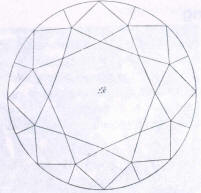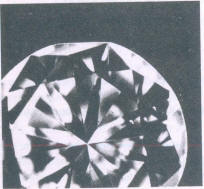The basis of a reliable and universally acceptable quality determination are clearly defined and universally applicable descriptions and especially definitions of descriptions for the typical type of inclusion in every clarity grade. A limiting factor is that because of the nearly limitless number of types of inclusions it is not possible to form an absolute definition. In the practice of clarity grading there will always be border-line cases which require a certain tolerance, even if the grading is done by experts.
The classification of internal defects in a clarity grade depends on many factors, which have to be considered and which only lead to a reliable determination if all aspects are taken into account. No two diamonds are alike, yet every grade of clarity comprises characteristic and specific features.
When examining the inclusions, it is most important to observe them through the crown:
-
size and number of inclusions
-
discernibility of inclusions
-
whether they can be seen with or without difficulty, with magnification or with the naked eye
-
-
appearance of inclusions
-
whether light, colorless or dark and colored
-
-
nature of inclusions
-
whether unalterable crystalline inclusions or risky cracks which could expand in the stone under pressure or a blow
-
-
position of inclusions
-
whether under the table or around the girdle
-
-
type of inclusion
-
whether compact or diffuse, dot-like or flat
-
-
influence on brilliance and durability of stone.
Measuring instruments which can register the size and number of inclusions, cannot take into account the other very important factors. Only the human eye can do that, therefore the author disagrees with the use of scanning microscopes for the "measurement" of inclusions for clarity grading.
An individual inclusion in a cut diamond can appear more definite than a collection of several smaller Inclusions and a colorless transparent mineral inclusion is less obvious than a colored inclusion of the same size. colored inclusions influence the brilliant effect more strongly and can easier be seen with the naked eye, while colorless inclusions up to a certain clarity grade can only be recognized with a 10 x magnification.
The position of the inclusions in a stone is also of importance. It is more easily discern able in the centre or Just under the table of a stone than under the pavilion facets or near the girdle. In the latter case it is more "hidden" by the edges of the facets and by the reflection of single facets because of the larger contrast between light and dark.
This may lead to the differential grading of two similar inclusions in different positions (Fig 44 and 45).
|
|
|
| Fig 44 A cloud under the table - VS 1 | Fig, 45 The cloud in Fig 45. positioned near to the girdle. VVS 2 |
Inclusions near the facet edge are often reflected in several facets (Fig 46 and 47), they are therefore more easily visible and their grading is lower than similar inclusions which are not reflected.
|
|
 |
| Fig 46 A light inclusion with two reflections | Fig 47 A crystal inclusion in the centre with several reflections in the pavilion (30x) |
Fracture-, cleavage- and tension-cracks can be enlarged and expanded by external mechanical stress (for instance during the setting or while removing a stone from its setting, exposure to blows or even taps, sudden temperature chances) and detract from the durability of the stone. Therefore larger cracks are generally evaluated somewhat lower than solid crystalline inclusions which cannot change any further.
Cracks which have an edge orientated in the viewing direction are evaluated higher than those perpendicular to the crack plane appearing flat and as a plane (Fig 48 a and b).
|
|
|
| Fig 48a A cleavage crack In the cleavage plane perpendicular to the viewing direction = pique 1 | Fig 48b The cleavage crack of Fig 45a with the edge of the crack perpendicular to the viewing -direction = SI |
Cracks which reach the surface of the stone contain sometimes a colored liquid which makes them more obvious and diminishes the brilliance.
Grades of clarity, similar to grades of color, form step-less transitions to the following grade with increasing size and number. It is difficult to clearly' define such quality steps', apart from the already mentioned conditions the following factors must be considered:
-
magnification used
-
condition of light
-
visual faculty
-
the grader.
As basis for clarity grading the 10 x magnification with an achromatic and aplanatic loupe is internationally accepted. This can refer to a hand loupe or a binocular lens of a microscope. The advantages and disadvantages of the two systems will be discussed later. The use of a loupe requires the normal or by glasses corrected sight of the grader.
The grading should be done by an expert in normal light conditions. The grader should not be a beginner, need not be a "expert", but should have some experience in diamond grading.
The light which should be used for the determination of the inclusions should be a white, diffuse light. The day-light lamp used for color-grading is a suitable instrument. A spot-light should not be used, because it causes strong surface reflections which make viewing of the interior of the stone more difficult. The commercial diamond microscopes have a built-in dark-field illumination, which illuminates from below through the pavilion facets. This advantageous illumination can also be made use of with a day-light lamp if the stone is held immediately in front of the lamp so that the light illuminates the stone from behind.
| Filled Diamonds | Definition of Clarity Grades |




